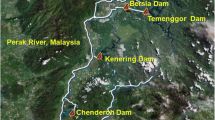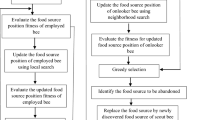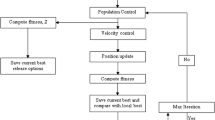Abstract
The paper presents a study on developing an effective reservoir operation policy by using artificial bee colony (ABC) algorithm. The decision maker of a reservoir system always needs a guideline to operate the reservoir in an optimal way. Such guidelines named ‘release curves’ have developed for high-, medium-, and low-inflow category that can answer how much water needs to be released for a month by observing the reservoir level (storage condition). The Aswan High Dam of Egypt has been considered for the case study. For comparing the model efficiency, another heuristic approach—genetic algorithm (GA)—has been used. So far, GA is well established and most popular in reservoir release optimization. Historical inflow data for 18 years have been used for simulation purpose, and the general system performance-measuring indices (such as reliability, resiliency, and vulnerability) have been measured. The application procedure and problem formulation of ABC are very simple and can be used in optimizing reservoir system. After using the actual historical inflow, the release policy succeeded in meeting demand for about 98 % of the total time period. According to the simulation results, ABC algorithm showed better performance than the GA approach in reservoir release optimization.







Similar content being viewed by others
References
El-Shafie Amr H, El-Shafie A, El Mazoghi HG, Shehata A, Taha MR (2011) Artificial neural network technique for rainfall forecasting applied to Alexandria, Egypt. Int J Phys Sci 6:1306–1316
El-Shafie A, Jaafer O, Seyed A (2011) Adaptive neuro-fuzzy inference system based model for rainfall forecasting in Klang River Malaysia. Int J Phys Sci 6:2875–2888
Noureldin A, El-Shafie A, Bayoumi M (2011) GPS/INS integration utilizing dynamic neural networks for vehicular navigation. Inf Fusion 12:48–57
Ahmad I, Kamruzzaman J, Habibi D (2011) Application of artificial intelligence to improve quality of service in computer networks. Neural Comput Appl 21:81–90. doi:10.1007/s00521-011-0622-6
Khajehzadeh M, Taha MR, El-Shafie A, Eslami M (2011) Modified particle swarm optimization for optimum design of spread footing and retaining wall. J Zhejiang Univ Sci A 12:415–427
Oliveira R, Loucks DP (1997) Operating rules for multireservoir systems. Water Resour Res 33:839–852
Chang FJ, Chen L (1998) Real-coded genetic algorithm for rule-based flood control reservoir management. Water Resour Manag 12:185–198
Wardlaw R, Sharif M (1999) Evaluation of genetic algorithms for optimal reservoir system operation. J Water Res Pl ASCE 125:25–33
Ahmed JA, Sarma AK (2005) Genetic algorithm for optimal operating policy of a multipurpose reservoir. Water Resour Manag 19:145–161. doi:10.1007/s11269-005-2704-7
Jothiprakash V, Shanthi G (2006) Single reservoir operation policies using genetic algorithm. Water Resour Manag 20:917–929. doi:10.1007/s11269-005-9014-y
Kumar DN, Reddy MJ (2007) Multipurpose reservoir operation using particle swarm optimization. Water Res Pl ASCE 133:192–201. doi:10.1061/(ASCE)0733-9496(2007)133:3(192)
Karaboga D (2005) An idea based on honey bee swarm for numerical optimization. Technical report—TR06. Kayseri, Turkey
Karaboga D, Basturk B (2007) A powerful and efficient algorithm for numerical function optimization: artificial bee colony (ABC) algorithm. J Global Optim 39:459–471. doi:10.1007/s10898-007-9149-x
Karaboga D, Basturk B (2008) On the performance of artificial bee colony (ABC) algorithm. Appl Soft Comput 8:687–697. doi:10.1016/j.asoc.2007.05.007
Karaboga D, Akay B (2009) A comparative study of artificial bee colony algorithm. Appl Math Comput 214:108–132. doi:10.1016/j.amc.2009.03.090
Kıran MS, Işcan H, Gunduz M (2012) The analysis of discrete artificial bee colony algorithm with neighborhood operator on traveling salesman problem. Neural Comput Appl. doi:10.1007/s00521-011-0794-0
MdS Maximiano, Vega-Rodrıguez MA, Gomez-Pulido JA, Sanchez-Perez JM (2012) A new Multiobjective Artificial Bee Colony algorithm to solve a real-world frequency assignment problem. Neural Comput Appl. doi:10.1007/s00521-012-1046-7
Wurbs RA (1996) Modeling and analysis of reservoir system operations. Prentice-Hall, Inc., Upper Saddle River, NJ
Goldberg DE, Deb K (1991) A comparative analysis of selection schemes used in genetic algorithms. In: Rawlins GJE (ed) Foundation of genetic algorithms. Morgan Kaufmann Publishers, California, pp 69–93
Haupt RL, Haupt SE (2004) Practical Genetic Algorithms, 2nd edn. John Wiley & Sons, Inc., New Jersey
Tereshko V (2000) Reaction-diffusion model of a honeybee colony’s foraging behavior. In: Proceedings of the PPSN VI: parallel problem solving from nature, lecture notes in computer science. Springer. pp 807–816
El-Shafie AH, El-Manadely MS (2011) An integrated neural network stochastic dynamic programming model for optimizing the operation policy of Aswan High Dam. Hydrol Res 42:50–67. doi:10.2166/nh.2010.043
Hashimoto T, Stedinger JR, Loucks DP (1982) Reliability, resiliency, and vulnerability criteria for water resource system performance evaluation. Water Resour Res 18:14–20
Author information
Authors and Affiliations
Corresponding author
Rights and permissions
About this article
Cite this article
Hossain, M.S., El-shafie, A. Performance analysis of artificial bee colony (ABC) algorithm in optimizing release policy of Aswan High Dam. Neural Comput & Applic 24, 1199–1206 (2014). https://doi.org/10.1007/s00521-012-1309-3
Received:
Accepted:
Published:
Issue Date:
DOI: https://doi.org/10.1007/s00521-012-1309-3




